Customer Satisfaction on Fashion Accessories: A Literature Review
VerifiedAdded on 2023/06/09
|8
|1540
|287
Report
AI Summary
This report provides a comprehensive literature review on customer satisfaction within the fashion accessories market, specifically focusing on the concept of conspicuous consumption. It examines four academic articles, including the foundational theory and three more recent studies employing quantitative, qualitative, and mixed-method research designs. The report analyzes common and differing themes, study limitations, and proposed future research directions. The analysis covers consumer behavior, luxury brands, and the impact of social media on purchasing decisions. It also explores the influence of cultural factors on brand perception and the role of self-monitoring attitudes. The report highlights the evolution of the theory, research methodologies, and the practical implications for businesses in the fashion industry. The report concludes with a segregation of references for easy navigation.
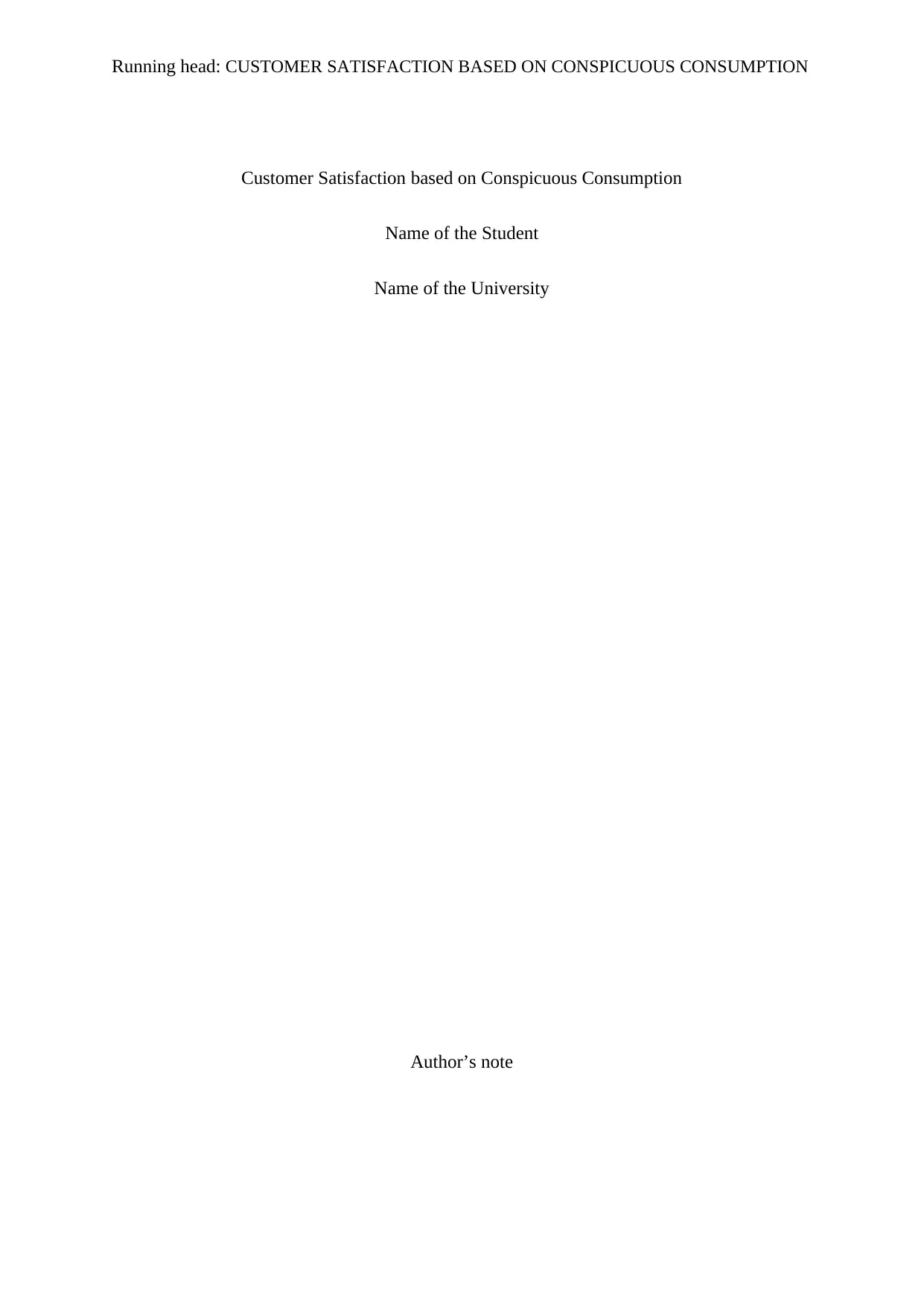
Running head: CUSTOMER SATISFACTION BASED ON CONSPICUOUS CONSUMPTION
Customer Satisfaction based on Conspicuous Consumption
Name of the Student
Name of the University
Author’s note
Customer Satisfaction based on Conspicuous Consumption
Name of the Student
Name of the University
Author’s note
Paraphrase This Document
Need a fresh take? Get an instant paraphrase of this document with our AI Paraphraser
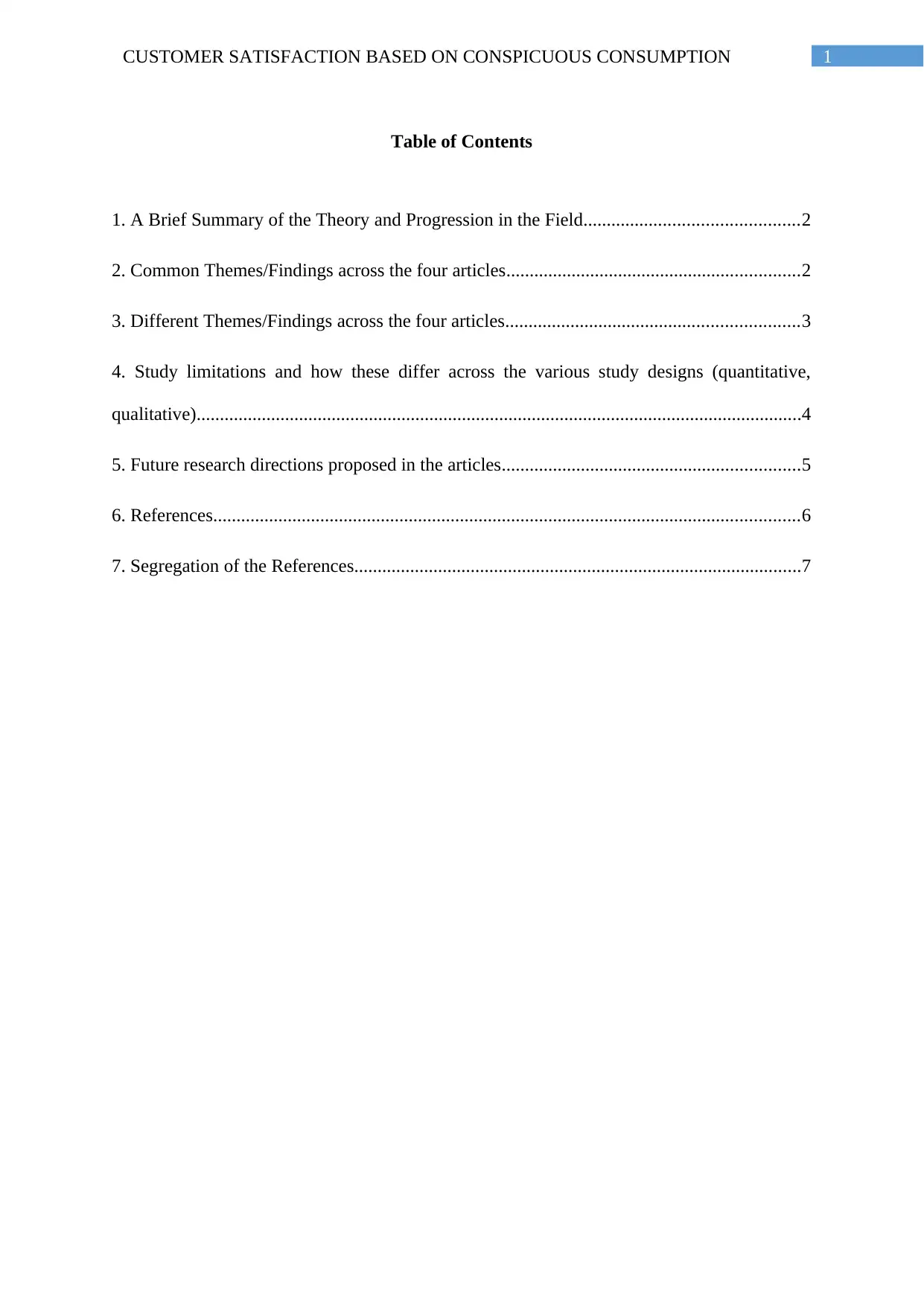
1CUSTOMER SATISFACTION BASED ON CONSPICUOUS CONSUMPTION
Table of Contents
1. A Brief Summary of the Theory and Progression in the Field..............................................2
2. Common Themes/Findings across the four articles...............................................................2
3. Different Themes/Findings across the four articles...............................................................3
4. Study limitations and how these differ across the various study designs (quantitative,
qualitative)..................................................................................................................................4
5. Future research directions proposed in the articles................................................................5
6. References..............................................................................................................................6
7. Segregation of the References................................................................................................7
Table of Contents
1. A Brief Summary of the Theory and Progression in the Field..............................................2
2. Common Themes/Findings across the four articles...............................................................2
3. Different Themes/Findings across the four articles...............................................................3
4. Study limitations and how these differ across the various study designs (quantitative,
qualitative)..................................................................................................................................4
5. Future research directions proposed in the articles................................................................5
6. References..............................................................................................................................6
7. Segregation of the References................................................................................................7
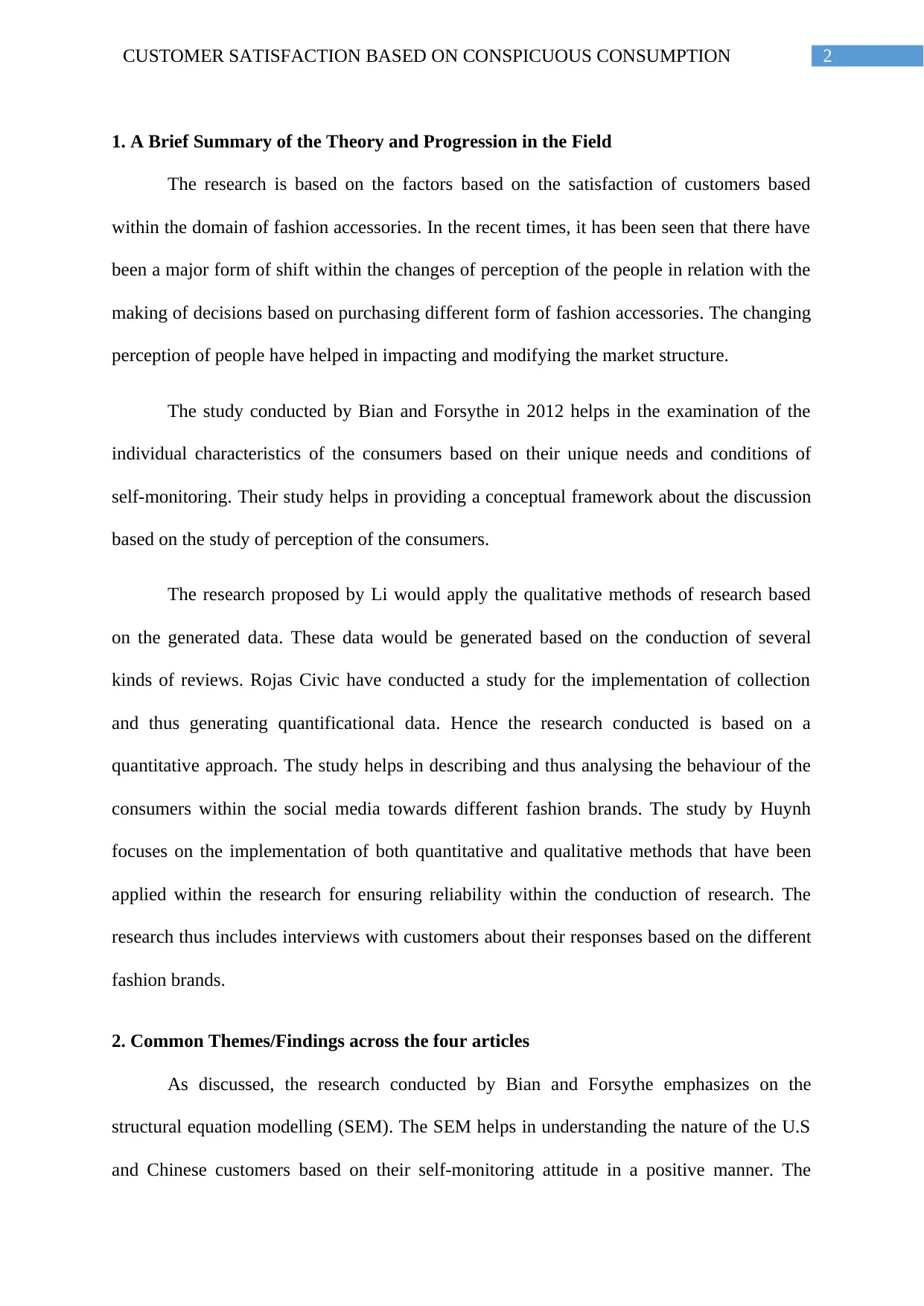
2CUSTOMER SATISFACTION BASED ON CONSPICUOUS CONSUMPTION
1. A Brief Summary of the Theory and Progression in the Field
The research is based on the factors based on the satisfaction of customers based
within the domain of fashion accessories. In the recent times, it has been seen that there have
been a major form of shift within the changes of perception of the people in relation with the
making of decisions based on purchasing different form of fashion accessories. The changing
perception of people have helped in impacting and modifying the market structure.
The study conducted by Bian and Forsythe in 2012 helps in the examination of the
individual characteristics of the consumers based on their unique needs and conditions of
self-monitoring. Their study helps in providing a conceptual framework about the discussion
based on the study of perception of the consumers.
The research proposed by Li would apply the qualitative methods of research based
on the generated data. These data would be generated based on the conduction of several
kinds of reviews. Rojas Civic have conducted a study for the implementation of collection
and thus generating quantificational data. Hence the research conducted is based on a
quantitative approach. The study helps in describing and thus analysing the behaviour of the
consumers within the social media towards different fashion brands. The study by Huynh
focuses on the implementation of both quantitative and qualitative methods that have been
applied within the research for ensuring reliability within the conduction of research. The
research thus includes interviews with customers about their responses based on the different
fashion brands.
2. Common Themes/Findings across the four articles
As discussed, the research conducted by Bian and Forsythe emphasizes on the
structural equation modelling (SEM). The SEM helps in understanding the nature of the U.S
and Chinese customers based on their self-monitoring attitude in a positive manner. The
1. A Brief Summary of the Theory and Progression in the Field
The research is based on the factors based on the satisfaction of customers based
within the domain of fashion accessories. In the recent times, it has been seen that there have
been a major form of shift within the changes of perception of the people in relation with the
making of decisions based on purchasing different form of fashion accessories. The changing
perception of people have helped in impacting and modifying the market structure.
The study conducted by Bian and Forsythe in 2012 helps in the examination of the
individual characteristics of the consumers based on their unique needs and conditions of
self-monitoring. Their study helps in providing a conceptual framework about the discussion
based on the study of perception of the consumers.
The research proposed by Li would apply the qualitative methods of research based
on the generated data. These data would be generated based on the conduction of several
kinds of reviews. Rojas Civic have conducted a study for the implementation of collection
and thus generating quantificational data. Hence the research conducted is based on a
quantitative approach. The study helps in describing and thus analysing the behaviour of the
consumers within the social media towards different fashion brands. The study by Huynh
focuses on the implementation of both quantitative and qualitative methods that have been
applied within the research for ensuring reliability within the conduction of research. The
research thus includes interviews with customers about their responses based on the different
fashion brands.
2. Common Themes/Findings across the four articles
As discussed, the research conducted by Bian and Forsythe emphasizes on the
structural equation modelling (SEM). The SEM helps in understanding the nature of the U.S
and Chinese customers based on their self-monitoring attitude in a positive manner. The
⊘ This is a preview!⊘
Do you want full access?
Subscribe today to unlock all pages.

Trusted by 1+ million students worldwide
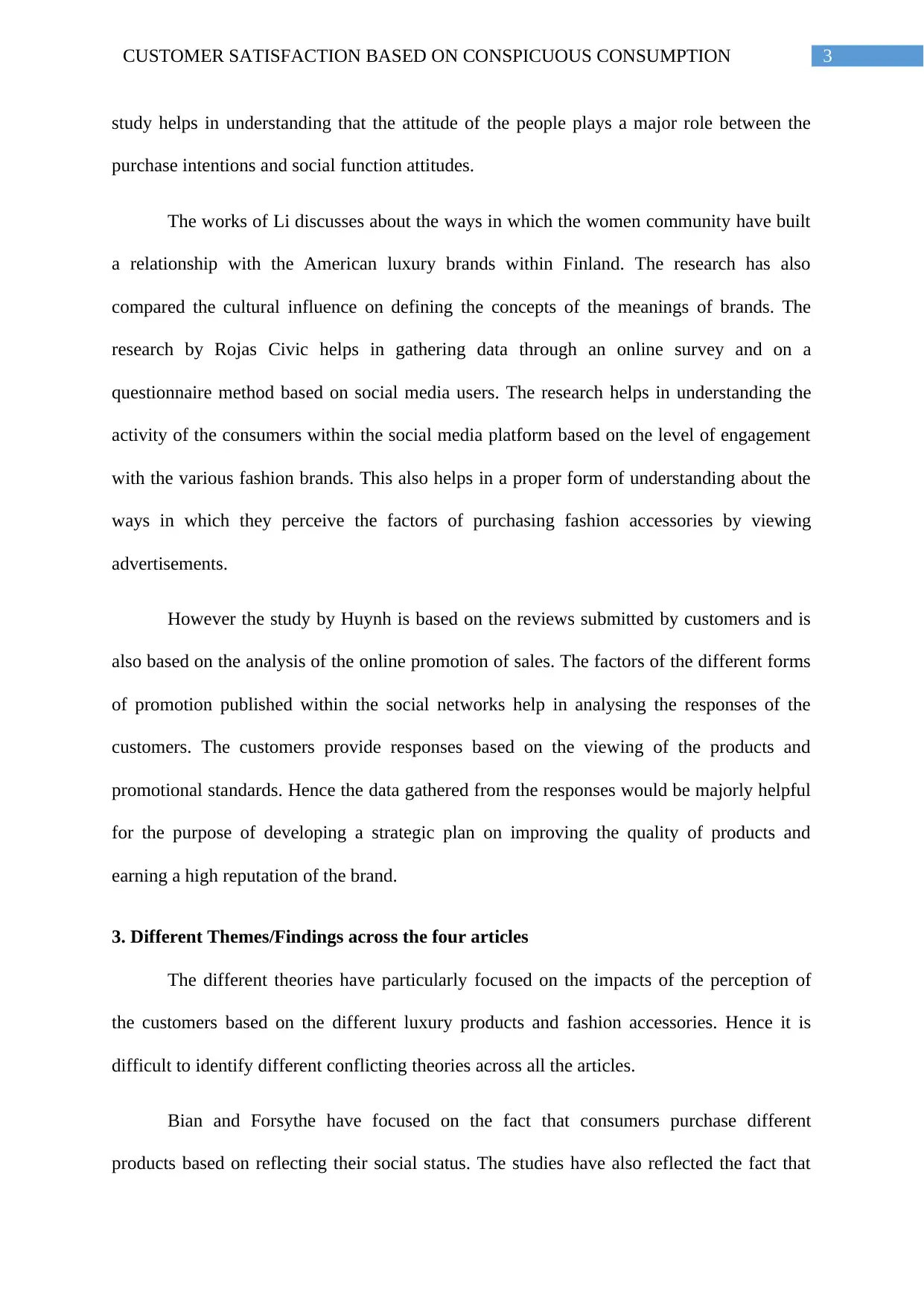
3CUSTOMER SATISFACTION BASED ON CONSPICUOUS CONSUMPTION
study helps in understanding that the attitude of the people plays a major role between the
purchase intentions and social function attitudes.
The works of Li discusses about the ways in which the women community have built
a relationship with the American luxury brands within Finland. The research has also
compared the cultural influence on defining the concepts of the meanings of brands. The
research by Rojas Civic helps in gathering data through an online survey and on a
questionnaire method based on social media users. The research helps in understanding the
activity of the consumers within the social media platform based on the level of engagement
with the various fashion brands. This also helps in a proper form of understanding about the
ways in which they perceive the factors of purchasing fashion accessories by viewing
advertisements.
However the study by Huynh is based on the reviews submitted by customers and is
also based on the analysis of the online promotion of sales. The factors of the different forms
of promotion published within the social networks help in analysing the responses of the
customers. The customers provide responses based on the viewing of the products and
promotional standards. Hence the data gathered from the responses would be majorly helpful
for the purpose of developing a strategic plan on improving the quality of products and
earning a high reputation of the brand.
3. Different Themes/Findings across the four articles
The different theories have particularly focused on the impacts of the perception of
the customers based on the different luxury products and fashion accessories. Hence it is
difficult to identify different conflicting theories across all the articles.
Bian and Forsythe have focused on the fact that consumers purchase different
products based on reflecting their social status. The studies have also reflected the fact that
study helps in understanding that the attitude of the people plays a major role between the
purchase intentions and social function attitudes.
The works of Li discusses about the ways in which the women community have built
a relationship with the American luxury brands within Finland. The research has also
compared the cultural influence on defining the concepts of the meanings of brands. The
research by Rojas Civic helps in gathering data through an online survey and on a
questionnaire method based on social media users. The research helps in understanding the
activity of the consumers within the social media platform based on the level of engagement
with the various fashion brands. This also helps in a proper form of understanding about the
ways in which they perceive the factors of purchasing fashion accessories by viewing
advertisements.
However the study by Huynh is based on the reviews submitted by customers and is
also based on the analysis of the online promotion of sales. The factors of the different forms
of promotion published within the social networks help in analysing the responses of the
customers. The customers provide responses based on the viewing of the products and
promotional standards. Hence the data gathered from the responses would be majorly helpful
for the purpose of developing a strategic plan on improving the quality of products and
earning a high reputation of the brand.
3. Different Themes/Findings across the four articles
The different theories have particularly focused on the impacts of the perception of
the customers based on the different luxury products and fashion accessories. Hence it is
difficult to identify different conflicting theories across all the articles.
Bian and Forsythe have focused on the fact that consumers purchase different
products based on reflecting their social status. The studies have also reflected the fact that
Paraphrase This Document
Need a fresh take? Get an instant paraphrase of this document with our AI Paraphraser
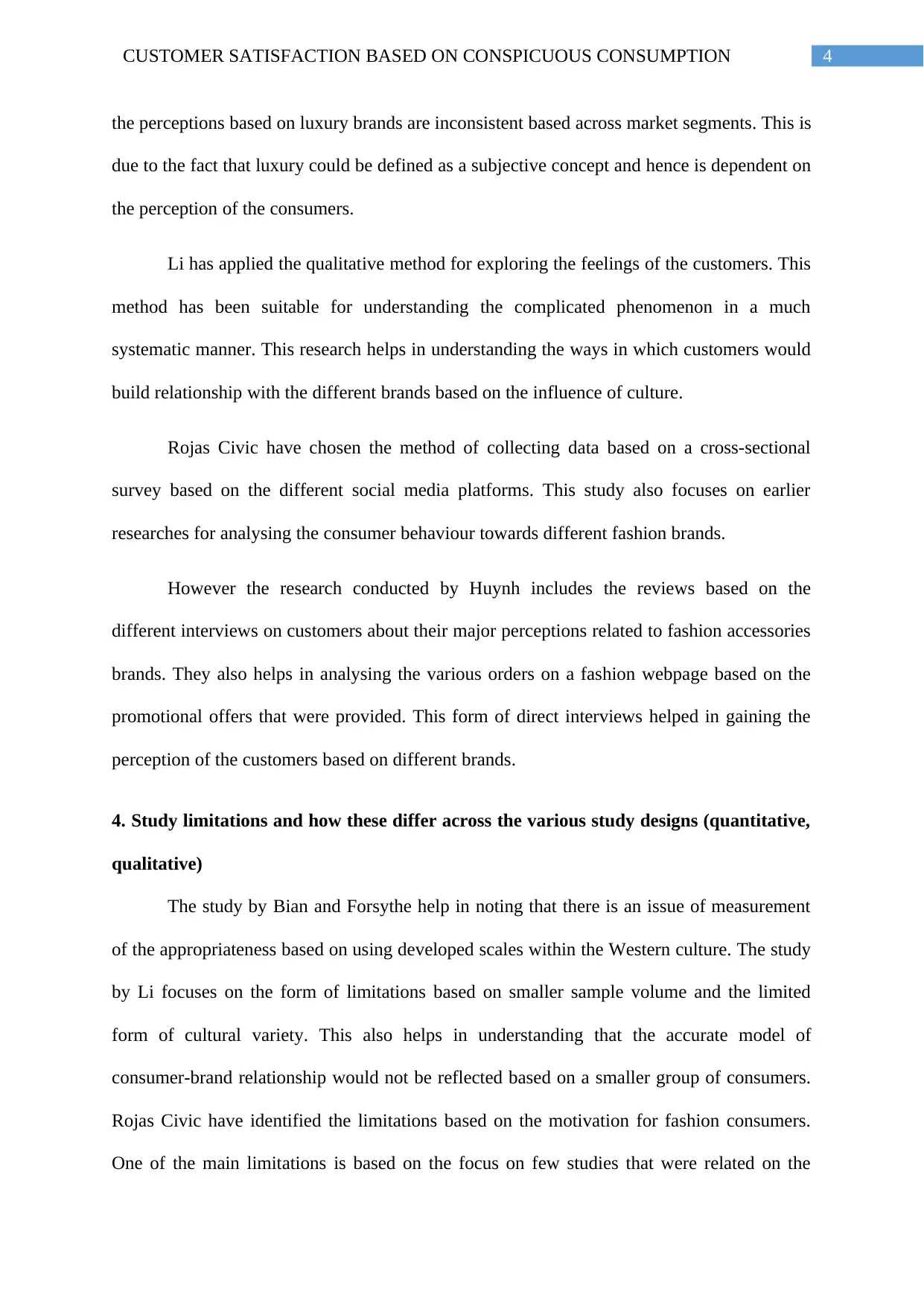
4CUSTOMER SATISFACTION BASED ON CONSPICUOUS CONSUMPTION
the perceptions based on luxury brands are inconsistent based across market segments. This is
due to the fact that luxury could be defined as a subjective concept and hence is dependent on
the perception of the consumers.
Li has applied the qualitative method for exploring the feelings of the customers. This
method has been suitable for understanding the complicated phenomenon in a much
systematic manner. This research helps in understanding the ways in which customers would
build relationship with the different brands based on the influence of culture.
Rojas Civic have chosen the method of collecting data based on a cross-sectional
survey based on the different social media platforms. This study also focuses on earlier
researches for analysing the consumer behaviour towards different fashion brands.
However the research conducted by Huynh includes the reviews based on the
different interviews on customers about their major perceptions related to fashion accessories
brands. They also helps in analysing the various orders on a fashion webpage based on the
promotional offers that were provided. This form of direct interviews helped in gaining the
perception of the customers based on different brands.
4. Study limitations and how these differ across the various study designs (quantitative,
qualitative)
The study by Bian and Forsythe help in noting that there is an issue of measurement
of the appropriateness based on using developed scales within the Western culture. The study
by Li focuses on the form of limitations based on smaller sample volume and the limited
form of cultural variety. This also helps in understanding that the accurate model of
consumer-brand relationship would not be reflected based on a smaller group of consumers.
Rojas Civic have identified the limitations based on the motivation for fashion consumers.
One of the main limitations is based on the focus on few studies that were related on the
the perceptions based on luxury brands are inconsistent based across market segments. This is
due to the fact that luxury could be defined as a subjective concept and hence is dependent on
the perception of the consumers.
Li has applied the qualitative method for exploring the feelings of the customers. This
method has been suitable for understanding the complicated phenomenon in a much
systematic manner. This research helps in understanding the ways in which customers would
build relationship with the different brands based on the influence of culture.
Rojas Civic have chosen the method of collecting data based on a cross-sectional
survey based on the different social media platforms. This study also focuses on earlier
researches for analysing the consumer behaviour towards different fashion brands.
However the research conducted by Huynh includes the reviews based on the
different interviews on customers about their major perceptions related to fashion accessories
brands. They also helps in analysing the various orders on a fashion webpage based on the
promotional offers that were provided. This form of direct interviews helped in gaining the
perception of the customers based on different brands.
4. Study limitations and how these differ across the various study designs (quantitative,
qualitative)
The study by Bian and Forsythe help in noting that there is an issue of measurement
of the appropriateness based on using developed scales within the Western culture. The study
by Li focuses on the form of limitations based on smaller sample volume and the limited
form of cultural variety. This also helps in understanding that the accurate model of
consumer-brand relationship would not be reflected based on a smaller group of consumers.
Rojas Civic have identified the limitations based on the motivation for fashion consumers.
One of the main limitations is based on the focus on few studies that were related on the
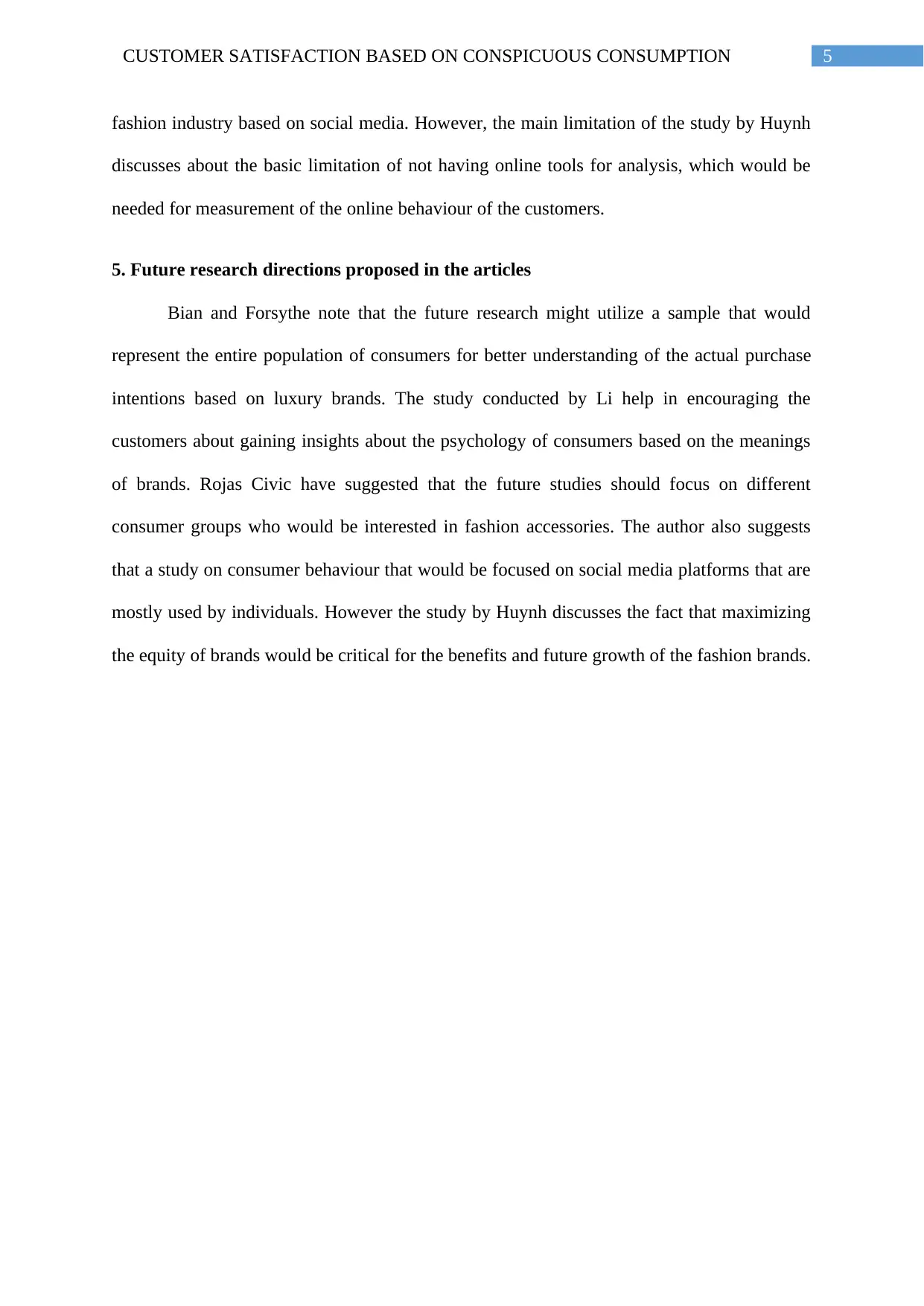
5CUSTOMER SATISFACTION BASED ON CONSPICUOUS CONSUMPTION
fashion industry based on social media. However, the main limitation of the study by Huynh
discusses about the basic limitation of not having online tools for analysis, which would be
needed for measurement of the online behaviour of the customers.
5. Future research directions proposed in the articles
Bian and Forsythe note that the future research might utilize a sample that would
represent the entire population of consumers for better understanding of the actual purchase
intentions based on luxury brands. The study conducted by Li help in encouraging the
customers about gaining insights about the psychology of consumers based on the meanings
of brands. Rojas Civic have suggested that the future studies should focus on different
consumer groups who would be interested in fashion accessories. The author also suggests
that a study on consumer behaviour that would be focused on social media platforms that are
mostly used by individuals. However the study by Huynh discusses the fact that maximizing
the equity of brands would be critical for the benefits and future growth of the fashion brands.
fashion industry based on social media. However, the main limitation of the study by Huynh
discusses about the basic limitation of not having online tools for analysis, which would be
needed for measurement of the online behaviour of the customers.
5. Future research directions proposed in the articles
Bian and Forsythe note that the future research might utilize a sample that would
represent the entire population of consumers for better understanding of the actual purchase
intentions based on luxury brands. The study conducted by Li help in encouraging the
customers about gaining insights about the psychology of consumers based on the meanings
of brands. Rojas Civic have suggested that the future studies should focus on different
consumer groups who would be interested in fashion accessories. The author also suggests
that a study on consumer behaviour that would be focused on social media platforms that are
mostly used by individuals. However the study by Huynh discusses the fact that maximizing
the equity of brands would be critical for the benefits and future growth of the fashion brands.
⊘ This is a preview!⊘
Do you want full access?
Subscribe today to unlock all pages.

Trusted by 1+ million students worldwide
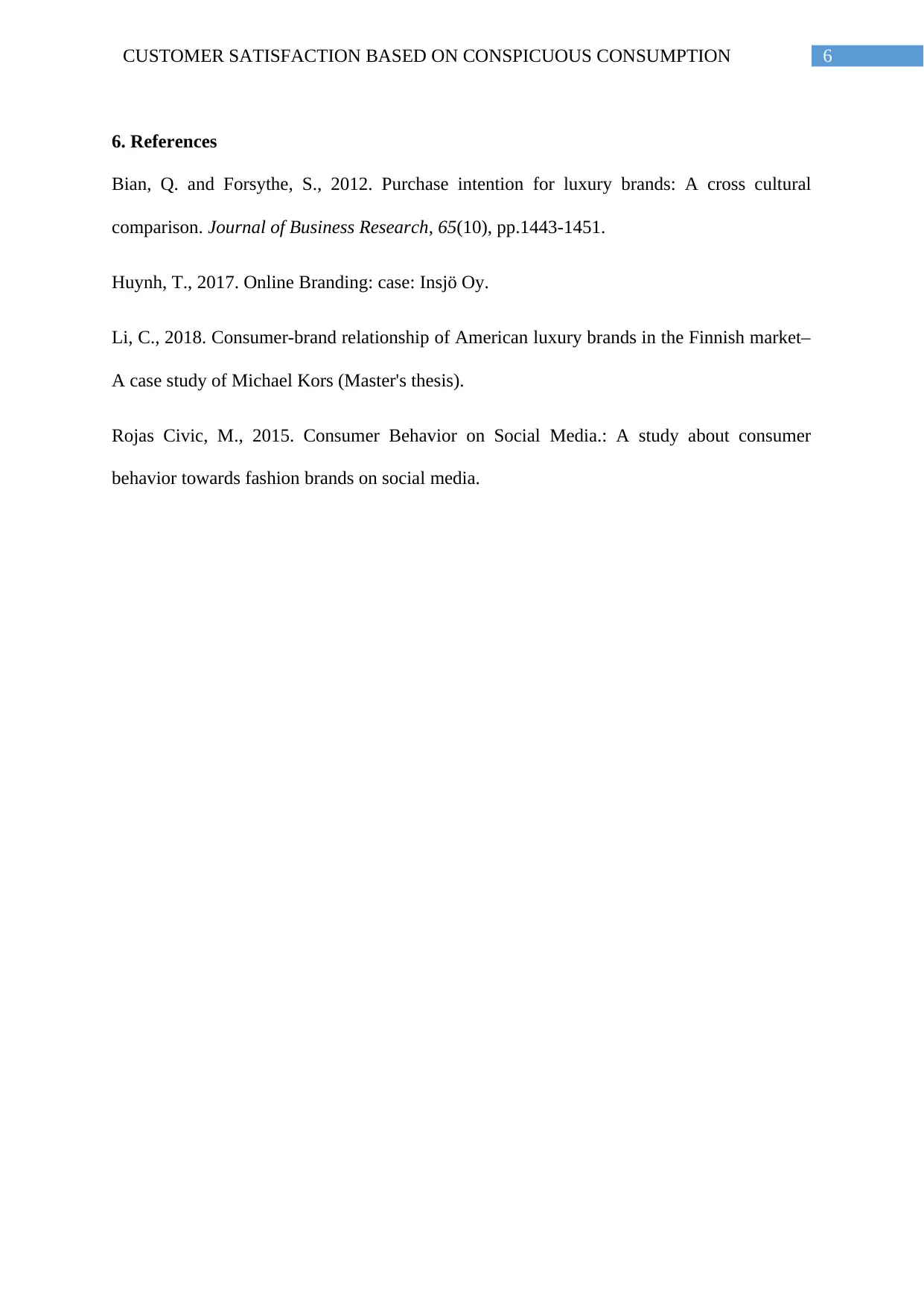
6CUSTOMER SATISFACTION BASED ON CONSPICUOUS CONSUMPTION
6. References
Bian, Q. and Forsythe, S., 2012. Purchase intention for luxury brands: A cross cultural
comparison. Journal of Business Research, 65(10), pp.1443-1451.
Huynh, T., 2017. Online Branding: case: Insjö Oy.
Li, C., 2018. Consumer-brand relationship of American luxury brands in the Finnish market–
A case study of Michael Kors (Master's thesis).
Rojas Civic, M., 2015. Consumer Behavior on Social Media.: A study about consumer
behavior towards fashion brands on social media.
6. References
Bian, Q. and Forsythe, S., 2012. Purchase intention for luxury brands: A cross cultural
comparison. Journal of Business Research, 65(10), pp.1443-1451.
Huynh, T., 2017. Online Branding: case: Insjö Oy.
Li, C., 2018. Consumer-brand relationship of American luxury brands in the Finnish market–
A case study of Michael Kors (Master's thesis).
Rojas Civic, M., 2015. Consumer Behavior on Social Media.: A study about consumer
behavior towards fashion brands on social media.
Paraphrase This Document
Need a fresh take? Get an instant paraphrase of this document with our AI Paraphraser
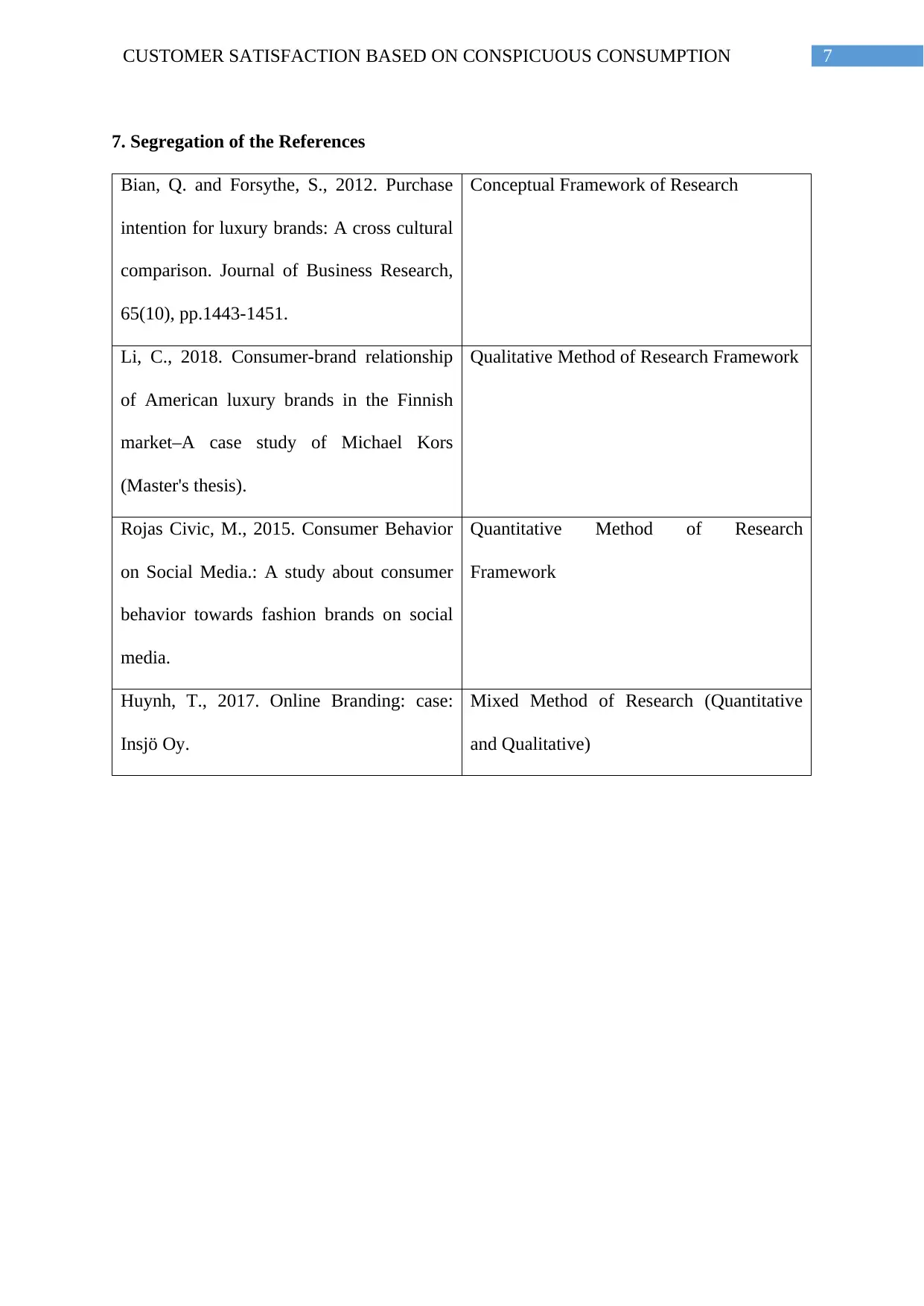
7CUSTOMER SATISFACTION BASED ON CONSPICUOUS CONSUMPTION
7. Segregation of the References
Bian, Q. and Forsythe, S., 2012. Purchase
intention for luxury brands: A cross cultural
comparison. Journal of Business Research,
65(10), pp.1443-1451.
Conceptual Framework of Research
Li, C., 2018. Consumer-brand relationship
of American luxury brands in the Finnish
market–A case study of Michael Kors
(Master's thesis).
Qualitative Method of Research Framework
Rojas Civic, M., 2015. Consumer Behavior
on Social Media.: A study about consumer
behavior towards fashion brands on social
media.
Quantitative Method of Research
Framework
Huynh, T., 2017. Online Branding: case:
Insjö Oy.
Mixed Method of Research (Quantitative
and Qualitative)
7. Segregation of the References
Bian, Q. and Forsythe, S., 2012. Purchase
intention for luxury brands: A cross cultural
comparison. Journal of Business Research,
65(10), pp.1443-1451.
Conceptual Framework of Research
Li, C., 2018. Consumer-brand relationship
of American luxury brands in the Finnish
market–A case study of Michael Kors
(Master's thesis).
Qualitative Method of Research Framework
Rojas Civic, M., 2015. Consumer Behavior
on Social Media.: A study about consumer
behavior towards fashion brands on social
media.
Quantitative Method of Research
Framework
Huynh, T., 2017. Online Branding: case:
Insjö Oy.
Mixed Method of Research (Quantitative
and Qualitative)
1 out of 8
Related Documents
Your All-in-One AI-Powered Toolkit for Academic Success.
+13062052269
info@desklib.com
Available 24*7 on WhatsApp / Email
![[object Object]](/_next/static/media/star-bottom.7253800d.svg)
Unlock your academic potential
Copyright © 2020–2025 A2Z Services. All Rights Reserved. Developed and managed by ZUCOL.





